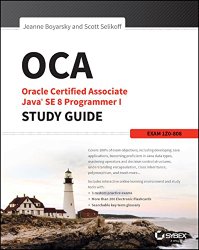
Jeanne Boyarsky and Scott Selikoff’s OCA 8 (or 11) study guide can be used to study for the Java Foundations exam. The book, OCA: Oracle Certified Associate Java SE 8 Programmer I Study Guide: Exam 1Z04-808 is published by Wiley Publishing.
We are using this blog to publish information about how to use the book to study for the Java Foundation exam. See our OCA page for more details including errata and how to contact us.
Keys Links
- Java Foundations official exam page
- Objective mapping between Java OCA 8 and Java Foundations exam
- Pearson VUE (register for the test) and ID requirements
- Cert View (check your score). See blog on how to register (English) or blog on how register (other languages)
Where to buy the books
- Amazon paper and ebook (Amazon sells the book for less than everyone else)
- Barnes and Noble paper and nook
- Wiley
- Goodreads (links to many book sellers)
Oracle has a tendency to change this information from time to time. As of now:
Length: 2 hours (was 2.5 hours until the end of August 2022)
# questions: 60 (was 70 until the end of August 2022)
Passing score: 65%
Changes to objectives
None so far
Blog posts related to Java Foundations (1Z0-811) exam
- Difference between entry level exams (and why you should take the OCA instead)
- Choosing between the Java Foundations exam and the OCP
Supplemental material
If you are using an OCA book to study for the Java Foundations exam, it will contain most of what you need to know. There are a few extra topics. We have blog posts including sample questions to cover this extra material.
| Objective | Topic | How to study |
|---|---|---|
| 1.2 | Describe the real-world applications of Java | Blog post on real world applications of Java |
| 2.1 | Describe the Java Development Kit (JDK) and the Java Runtime Environment (JRE) | There’s not much to this. The javac command is used to turn .java (source) files into .class (bytecode files). The javac command is part of the JDK. The java command is used to run .class files. It is part of the JRE. The JDK contains the JRE along with debugging tools and more. |
| 2.4 | Compiling and executing a Java program | This is covered in OCA books. It isn’t on the OCA exam at the moment so a brief review here:javac Hello.javajava HelloPay attention to the extension (or lack thereof) |
| 6.2 | Format Strings using escape sequences including %d, %n, and %s | Blog post on formatting Strings |
| 7.1 | Use the Random class | Blog post on Random and Math |
| 7.2 | Use the Math class | Blog post on Random and Math |
| 8.4 | Compare two String objects by using compareTo | Blog post on compareTo |
| 11.3 | Traverse the elements of an ArrayList by using iterators | Blog post on iterators |
